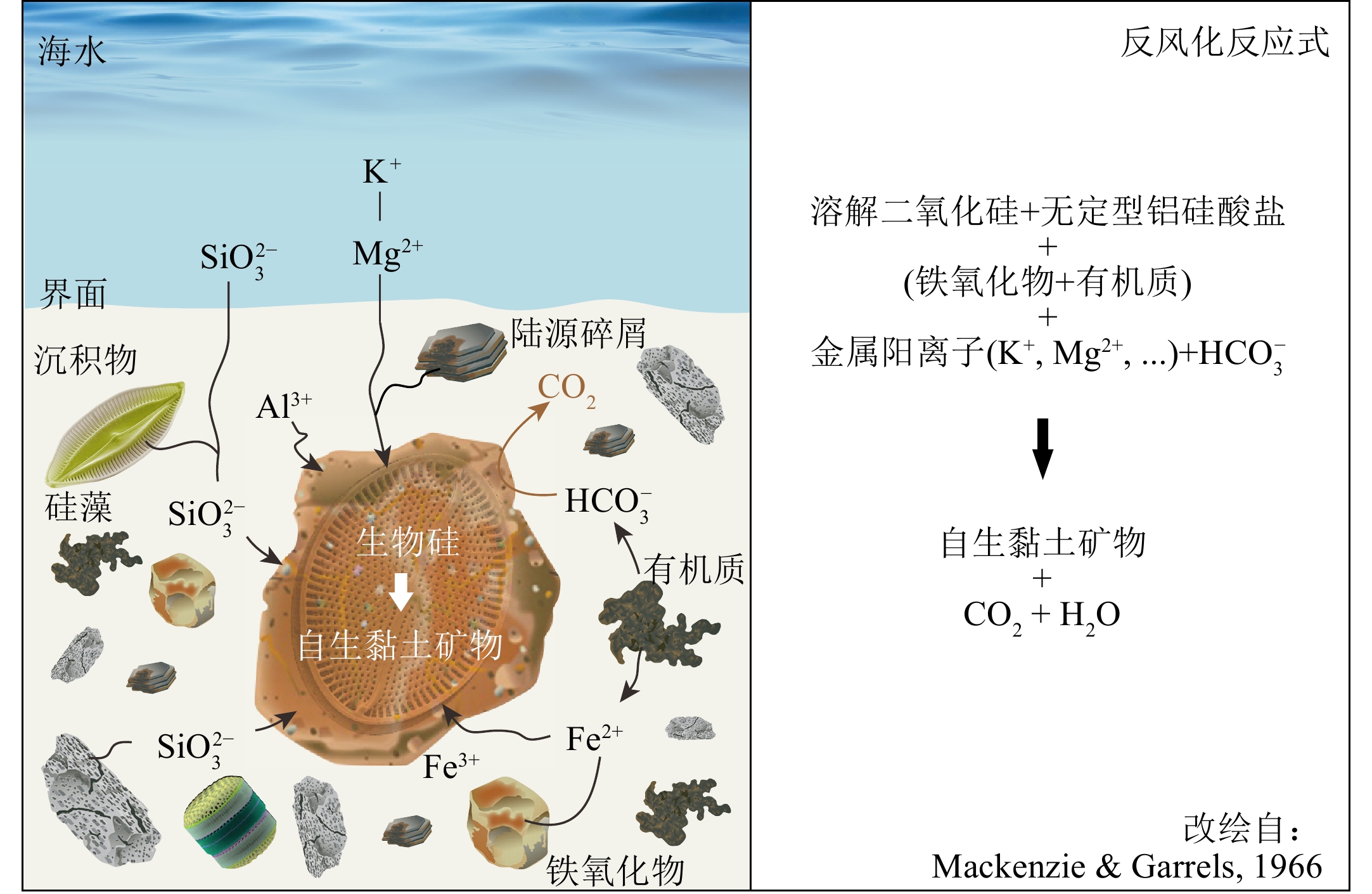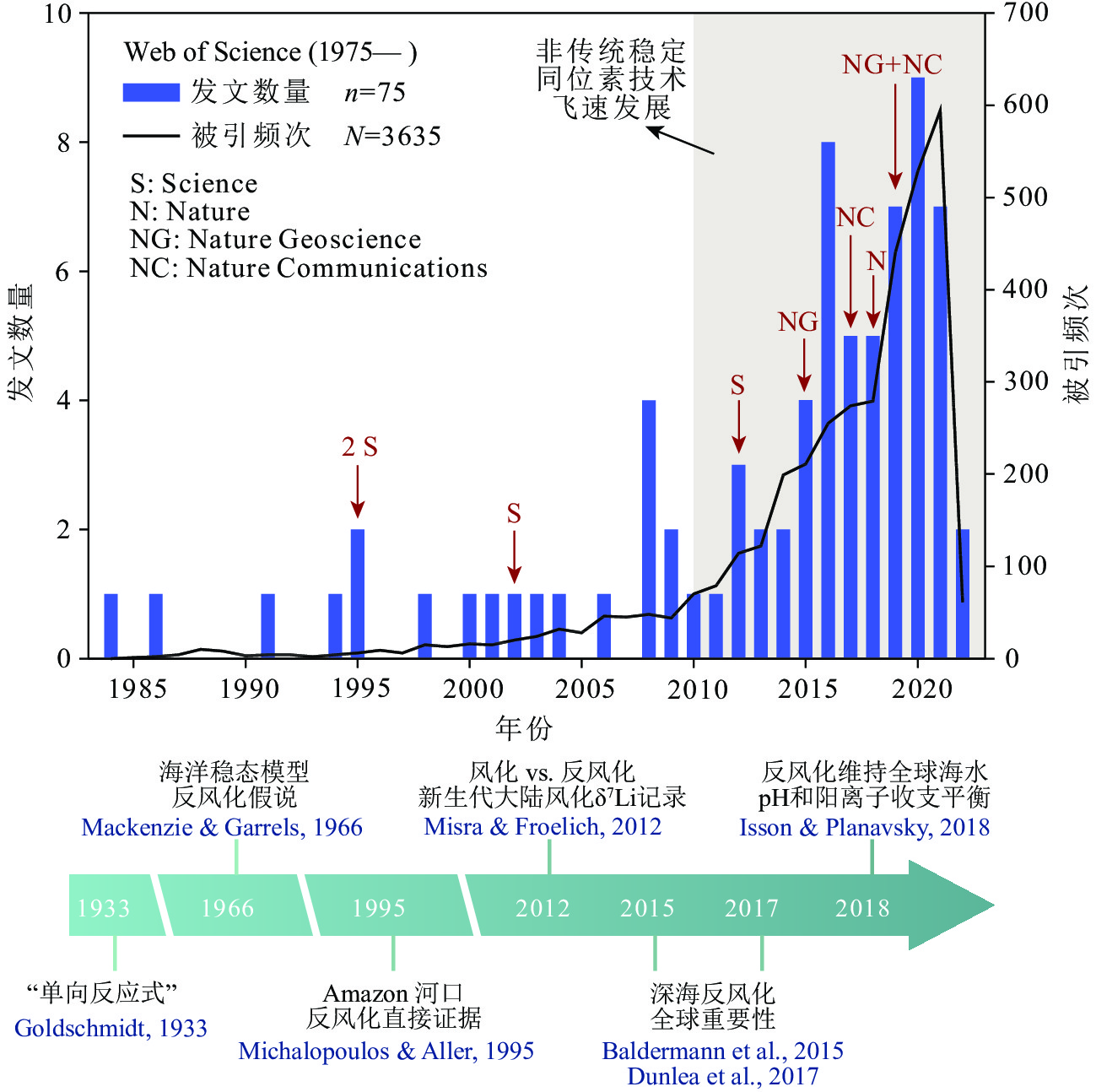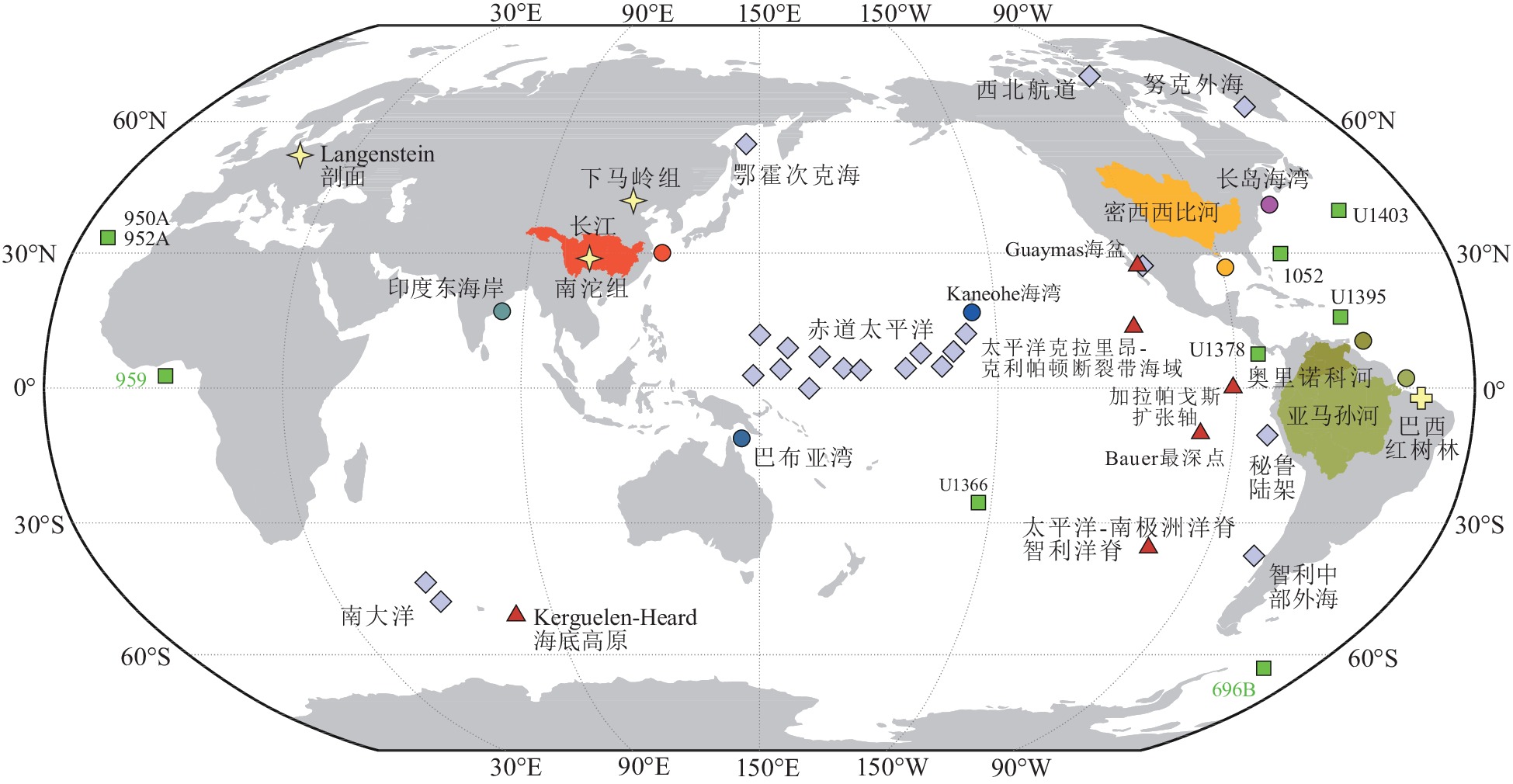Submarine reverse weathering and its effect on oceanic elements cycling
-
摘要:
海洋环境中的反风化作用是指硅与可溶性阳离子结合形成自生铝硅酸盐矿物(黏土),同时消耗海洋碱度并释放CO2的过程。反风化假说提出半个多世纪以来,作为全球海洋碳、硅和关键元素循环以及海洋碱度的重要调控机制,越来越受到学术界的关注。反风化作用可发生在河口三角洲与边缘海、热液或深埋藏的成岩环境以及深海远洋等环境,但不同海洋环境中的反风化反应从发生时间尺度到反应限制因素都具有差异。反风化作用研究的主要方法包括自生硅酸盐矿物的直接观测、孔隙水与沉积物的化学分析、实验模拟和模型研究等,而反风化作用的程度量化、限制因子解析和对海洋关键元素循环的影响一直是反风化研究的关键问题。当前快速发展的非传统稳定(金属)同位素技术为反风化研究带来了新机遇。东亚大陆边缘发育世界特大河口三角洲、宽广陆架以及特色热液活动区,泥质沉积体系发育,界面交换活跃,是开展大陆边缘反风化研究的天然实验室。
Abstract:Reverse weathering in the marine environment refers to the process in which silicon reacts with soluble cations to form authigenic aluminosilicate minerals (clays), while consuming ocean alkalinity and releasing CO2. The reverse weathering hypothesis was proposed in 1966 and has attracted rapidly increasing research attention over the last two decades. It has been regarded as an important mechanism regulating global carbon, oceanic silicon and key element cycles, and ocean alkalinity. Reverse weathering can occur in various marine environments including estuarine deltas and marginal seas, hydrothermal or deeply buried diagenetic environments, and deep oceans. The reaction timescales of reverse weathering vary widely, ranging from days to millions of years, and the controlling factors of the reactions are also significantly different in different marine environments. The major research methods of reverse weathering include direct observation of authigenic silicate minerals, chemical analysis of pore water and sediments, and experimental simulation and modelling, etc. The quantification of the degree of reverse weathering, the determination of limiting factors, and evaluation of its influence on the key element cycling have always been the key issues in the research of reverse weathering. The rapid development of non-traditional stable (metal) isotopes may allow us to better constrain the reverse weathering research. The East Asian continental margin is featured by the world's largest river delta, wide continental shelf, and characteristic hydrothermal activity, whose unique muddy sedimentary systems and active interface reactions and processes make the continental margin a natural laboratory for the integrated study of reverse weathering.
-
Key words:
- reverse weathering /
- oceanic elemental cycle /
- carbon cycle /
- authigenic clay /
- continental margin
-

-
图 1 反风化反应示意图[1]
Figure 1.
-
[1] Mackenzie F T, Garrels R M. Chemical balance between rivers and oceans [J]. American Journal of Science, 1966, 264(7): 507-525. doi: 10.2475/ajs.264.7.507
[2] Mackenzie F T, Kump L R. Reverse Weathering, Clay Mineral Formation, and Oceanic Element Cycles [J]. Science, 1995, 270(5236): 586-587. doi: 10.1126/science.270.5236.586
[3] Ristvet B L. Reverse Weathering Reactions within Recent Nearshore Marine Sediments, Kaneohe Bay, Oahu[D]. Honolulu, University of Hawaii, 1978.
[4] Von Damm K L, Edmond J M. Reverse weathering in the closed-basin lakes of the Ethiopian Rift [J]. American Journal of Science, 1984, 284: 835-862. doi: 10.2475/ajs.284.7.835
[5] Goldschmidt V M. Grundlagen der quantitativen Geochemie. Fortschritte der Mineralogie, Kristallographie und Petrographie[J]. 1933, 17: 112-156.
[6] Garrels R M. Silica: role in the buffering of natural waters [J]. Science, 1965, 148(3666): 69. doi: 10.1126/science.148.3666.69
[7] Sillén L G. The physical chemistry of seawater[M]//Sears M. Oceanography. Washington: AAAS Publisher, 1961: 549-82.
[8] Sillén L G. The ocean as a chemical system [J]. Science, 1967, 156(3779): 1189-1197. doi: 10.1126/science.156.3779.1189
[9] Corliss J B, Dymond J, Gordon L, et al. Submarine thermal springs on the Galapagos Rift [J]. Science, 1979, 203(4385): 1073-1083. doi: 10.1126/science.203.4385.1073
[10] Rona P A. New evidence for seabed resources from global tectonics [J]. Ocean Management, 1973, 1: 145-159. doi: 10.1016/0302-184X(73)90009-7
[11] Scott R B, Rona P A, Mcgregor B A. The TAG hydrothermal field [J]. Nature, 1974, 251(5473): 301-302. doi: 10.1038/251301a0
[12] Michalopoulos P, Aller R C. Rapid Clay Mineral Formation in Amazon Delta Sediments: Reverse Weathering and Oceanic Elemental Cycles [J]. Science, 1995, 270(5236): 614-617. doi: 10.1126/science.270.5236.614
[13] Michalopoulos P, Aller R C. Conversion of diatoms to clays during early diagenesis in tropical, continental shelf muds [J]. Geology, 2000, 28(12): 1095-1098. doi: 10.1130/0091-7613(2000)28<1095:CODTCD>2.0.CO;2
[14] Michalopoulos P, Aller R C. Early diagenesis of biogenic silica in the Amazon delta: alteration, authigenic clay formation, and storage [J]. Geochimica et Cosmochimica Acta, 2004, 68(5): 1061-1085. doi: 10.1016/j.gca.2003.07.018
[15] Misra S, Froelich P N. Lithium Isotope History of Cenozoic Seawater: Changes in Silicate Weathering and Reverse Weathering [J]. Science, 2012, 335(6070): 818-823. doi: 10.1126/science.1214697
[16] Dunlea A G, Murray RW, Santiago Ramos D P, et al. Cenozoic global cooling and increased seawater Mg/Ca via reduced reverse weathering [J]. Nature Communications, 2017, 8(1): 844. doi: 10.1038/s41467-017-00853-5
[17] Isson T T, Planavsky N J. Reverse weathering as a long-term stabilizer of marine pH and planetary climate [J]. Nature, 2018, 560(7719): 471-475. doi: 10.1038/s41586-018-0408-4
[18] Isson T T, Planavsky N J, Coogan L A, et al. Evolution of the global carbon cycle and climate regulation on earth [J]. Global Biogeochemical Cycles, 2020, 34(2): e2018GB006061.
[19] Zhang X, Gaillardet J, Barrier L, et al. Li and Si isotopes reveal authigenic clay formation in a palaeo-delta [J]. Earth and Planetary Science Letters, 2022, 578: 117339. doi: 10.1016/j.jpgl.2021.117339
[20] Hilton R G, West A J. Mountains, erosion and the carbon cycle [J]. Nature Reviews Earth & Environment, 2020, 1(6): 284-299.
[21] Berner R A. Early Diagenesis: A Theoretical Approach[M]. Princeton: Princeton University Press, 1980.
[22] Church T M. Marine Chemistry in the Coastal Environment: Principles, Perspective and Prospectus [J]. Aquatic Geochemistry, 2016, 22(4): 375-389. doi: 10.1007/s10498-016-9296-0
[23] Berner E K, Berner R A. Global Environment: Water, Air, and Geochemical Cycles[M]. Princeton: Princeton University Press, 2011.
[24] Krissansen-Totton J, Catling D C. A coupled carbon-silicon cycle model over Earth history: Reverse weathering as a possible explanation of a warm mid-Proterozoic climate [J]. Earth and Planetary Science Letters, 2020, 537: 116181. doi: 10.1016/j.jpgl.2020.116181
[25] Cao C, Bataille C P, Song H, et al. Persistent late permian to early triassic warmth linked to enhanced reverse weathering [J]. Nature Geoscience, 2022, 15: 832-838. doi: 10.1038/s41561-022-01009-x
[26] Geilert S, Frick D A, Garbe-Schönberg D, et al. Coastal El Niño triggers rapid marine silicate alteration on the seafloor [J]. Nature Communications, 2023, 14(1): 1676. doi: 10.1038/s41467-023-37186-5
[27] Baldermann A, Banerjee S, Czuppon G, et al. Impact of green clay authigenesis on element sequestration in marine settings [J]. Nature Communications, 2022, 13(1): 1527. doi: 10.1038/s41467-022-29223-6
[28] Loucaides S, Michalopoulos P, Presti M, et al. Seawater-mediated interactions between diatomaceous silica and terrigenous sediments: Results from long-term incubation experiments [J]. Chemical Geology, 2010, 270(1-4): 68-79. doi: 10.1016/j.chemgeo.2009.11.006
[29] Bennekom A, Gaast S. Possible clay structures in frustules of living diatoms [J]. Geochimica et Cosmochimica Acta, 1976, 40: 1149-1152. doi: 10.1016/0016-7037(76)90150-2
[30] Baldermann A, Warr L N, Letofsky-Papst I, et al. Substantial iron sequestration during green-clay authigenesis in modern deep-sea sediments [J]. Nature Geoscience, 2015, 8(11): 885-889. doi: 10.1038/ngeo2542
[31] Scholz F, Severmann S, Mcmanus J, et al. On the isotope composition of reactive iron in marine sediments: Redox shuttle versus early diagenesis [J]. Chemical Geology, 2014, 389: 48-59. doi: 10.1016/j.chemgeo.2014.09.009
[32] Boning P, Schnetger B, Belz L, et al. Sedimentary iron cycling in the Benguela upwelling system off Namibia [J]. Earth and Planetary Science Letters, 2020, 538: 116212. doi: 10.1016/j.jpgl.2020.116212
[33] Ehlert C, Doering K, Wallmann K, et al. Stable silicon isotope signatures of marine pore waters: Biogenic opal dissolution versus authigenic clay mineral formation [J]. Geochimica et Cosmochimica Acta, 2016, 191: 102-117. doi: 10.1016/j.gca.2016.07.022
[34] Li F, Penman D, Planavsky N, et al. Reverse weathering may amplify post-Snowball atmospheric carbon dioxide levels [J]. Precambrian Research, 2021, 364: 106279. doi: 10.1016/j.precamres.2021.106279
[35] Santiago Ramos D P, Coogan L A, Murphy J G, et al. Low-temperature oceanic crust alteration and the isotopic budgets of potassium and magnesium in seawater [J]. Earth and Planetary Science Letters, 2020, 541: 116290. doi: 10.1016/j.jpgl.2020.116290
[36] Steefel C I, Appelo C, Arora B, et al. Reactive transport codes for subsurface environmental simulation [J]. Computational Geosciences, 2015, 19(3): 445-478. doi: 10.1007/s10596-014-9443-x
[37] Wallmann K, Aloisi G, Haeckel M, et al. Silicate weathering in anoxic marine sediments [J]. Geochimica et Cosmochimica Acta, 2008, 72(12): 2895-2918. doi: 10.1016/j.gca.2008.03.026
[38] Geilert S, Grasse P, Doering K, et al. Impact of ambient conditions on the Si isotope fractionation in marine pore fluids during early diagenesis [J]. Biogeosciences, 2020, 17(7): 1745-1763. doi: 10.5194/bg-17-1745-2020
[39] Torres M E, Hong W L, Solomon E A, et al. Silicate weathering in anoxic marine sediment as a requirement for authigenic carbonate burial [J]. Earth-Science Reviews, 2020, 200: 102960. doi: 10.1016/j.earscirev.2019.102960
[40] Li W, Liu X-M, Wang K, et al. Potassium isotope signatures in modern marine sediments: Insights into early diagenesis [J]. Earth and Planetary Science Letters, 2022, 599: 117849. doi: 10.1016/j.jpgl.2022.117849
[41] Shalev N, Bontognali T, Wheat C G, et al. New isotope constraints on the Mg oceanic budget point to cryptic modern dolomite formation [J]. Nature Communications, 2019, 10(1): 5646. doi: 10.1038/s41467-019-13514-6
[42] Voigt M, Pearce C R, Fries D M, et al. Magnesium isotope fractionation during hydrothermal seawater–basalt interaction [J]. Geochimica et Cosmochimica Acta, 2019, 272: 21-35.
[43] Laureijs C T, Coogan L A, Spence J. Regionally variable timing and duration of celadonite formation in the Troodos lavas (Cyprus) from Rb-Sr age distributions [J]. Chemical Geology, 2021, 560(3): 119995.
[44] Homoky W B, Thomas W, Berelson W M, et al. Quantifying trace element and isotope fluxes at the ocean-sediment boundary: a review [J]. Philosophical Transactions of the Royal Society A:Mathematical, Physical and Engineering Sciences, 2016, 374: 20160246. doi: 10.1098/rsta.2016.0246
[45] Luo M, Li W, Geilert S, et al. Active Silica Diagenesis in the Deepest Hadal Trench Sediments [J]. Geophysical Research Letters, 2022, 49(14): e2022GL099365.
[46] Li G, West A J. Evolution of Cenozoic seawater lithium isotopes: Coupling of global denudation regime and shifting seawater sinks [J]. Earth and Planetary Science Letters, 2014, 401: 284-293. doi: 10.1016/j.jpgl.2014.06.011
[47] Coogan L A, Gillis K M. Temperature dependence of chemical exchange during seafloor weathering: Insights from the Troodos ophiolite [J]. Geochimica et Cosmochimica Acta, 2018, 243: 24-41. doi: 10.1016/j.gca.2018.09.025
[48] Higgins J A, Schrag D P. The Mg isotopic composition of Cenozoic seawater: evidence for a link between Mg-clays, seawater Mg/Ca, and climate [J]. Earth and Planetary Science Letters, 2015, 416: 73-81. doi: 10.1016/j.jpgl.2015.01.003
[49] Coggon R M, Teagle D A H, Smith-Duque C E, et al. Reconstructing Past Seawater Mg/Ca and Sr/Ca from Mid-Ocean Ridge Flank Calcium Carbonate Veins [J]. Science, 2010, 327(5969): 1114-1117. doi: 10.1126/science.1182252
[50] Masuda H. Iron-rich smectite formation in the hydrothermal sediment of Iheya Basin, Okinawa Trough[M]//Sakai H. , Nozaki Y. Biogeochemical Processes and Ocean Flux in the Western Pacific. Tokyo: Terra Scientific Publishing Company, 1995, 509-521.
[51] Stoffynegli P, Mackenzie F T. Mass balance of dissolved lithium in the oceans [J]. Geochimica et Cosmochimica Acta, 1984, 48(4): 859-872. doi: 10.1016/0016-7037(84)90107-8
[52] Chan L H, Edmond J M, Thompson G, et al. Lithium isotopic composition of submarine basalts: implications for the lithium cycle in the oceans [J]. Earth and Planetary Science Letters, 1992, 108(1-3): 151-160. doi: 10.1016/0012-821X(92)90067-6
[53] Huh Y, Chan L H, Zhang L, et al. Lithium and its isotopes in major world rivers: Implications for weathering and the oceanic budget [J]. Geochimica et Cosmochimica Acta, 1998, 62(12): 2039-2051. doi: 10.1016/S0016-7037(98)00126-4
[54] You C F, Chan L H, Gieskes J M, et al. Seawater intrusion through the oceanic crust and carbonate sediment in the Equatorial Pacific: Lithium abundance and isotopic evidence [J]. Geophysical Research Letters, 2003, 30(21): 1-4.
[55] Zhang L, Chan L H, Gieskes J M. Lithium isotope geochemistry of pore waters from ocean drilling program Sites 918 and 919, Irminger Basin [J]. Geochimica et Cosmochimica Acta, 1998, 62(14): 2437-2450. doi: 10.1016/S0016-7037(98)00178-1
[56] Andrews E, Strandmann P, Fantle M S. Exploring the importance of authigenic clay formation in the global Li cycle [J]. Geochimica et Cosmochimica Acta, 2020, 289: 47-68. doi: 10.1016/j.gca.2020.08.018
[57] Kawagucci S. Fluid geochemistry of high-temperature hydrothermal fields in the Okinawa trough[M]//Ihibashi J I, Okino K, Sunamura M. Subseafloor Biosphere Linked to Hydrothermal Systems: TAIGA Concept. Tokyo: Springer, 2015: 387-403.
[58] Araoka D, Nishio Y, Gamo T, et al. Lithium isotopic systematics of submarine vent fluids from arc and back-arc hydrothermal systems in the western Pacific [J]. Geochemistry Geophysics Geosystems, 2016, 17(10): 3835-3853. doi: 10.1002/2016GC006355
[59] Decitre S, Buatier M, James R. Li and Li isotopic composition of hydrothermally altered sediments at Middle Valley, Juan De Fuca[J]. Chemical Geology, 2004, 211(3-4): 363-373.
[60] Tréguer P J, Sutton J N, Brzezinski M, et al. Reviews and syntheses: The biogeochemical cycle of silicon in the modern ocean [J]. Biogeosciences, 2021, 18(4): 1269-1289. doi: 10.5194/bg-18-1269-2021
[61] Aller R C. Sedimentary diagenesis, depositional environments, and benthic fluxes[M]//Holland H D, Turekian K K. Treatise on Geochemistry. 2nd ed. Amsterdam: Elsevier, 2014: 293-334.
[62] Demaster D J. The supply and accumulation of silica in the marine environment [J]. Geochimica et Cosmochimica Acta, 1981, 45(10): 1715-1732. doi: 10.1016/0016-7037(81)90006-5
[63] Tréguer P J, Nelson D M, Aleido J V B, et al. The silica balance in the world ocean: a reestimate [J]. Science, 1995, 268(5209): 375-379. doi: 10.1126/science.268.5209.375
[64] Pondaven P, Ragueneau O, Tréguer P J, et al. Resolving the 'opal paradox' in the Southern Ocean [J]. Nature, 2000, 405(6783): 168-172. doi: 10.1038/35012046
[65] DeMaster D J. The accumulation and cycling of biogenic silica in the Southern Ocean: revisiting the marine silica budget [J]. Deep-Sea Research Part I:Topical Studies in Oceanography, 2002, 49(16): 3155-3167. doi: 10.1016/S0967-0645(02)00076-0
[66] La Laruelle G G, Roubeix V, Sferratore A, et al. Anthropogenic perturbations of the silicon cycle at the global scale: Key role of the land-ocean transition [J]. Global Biogeochemical Cycles, 2009, 23(4): GB4031.
[67] Tréguer P J, De La Rocha C L. The world ocean silica cycle [J]. Annual Review of Marine Science, 2013, 5: 477-501. doi: 10.1146/annurev-marine-121211-172346
[68] Rahman S, Aller R C, Cochran J K. Cosmogenic 32Si as a tracer of biogenic silica burial and diagenesis: Major deltaic sinks in the silica cycle [J]. Geophysical Research Letters, 2016, 43(13): 7124-7132. doi: 10.1002/2016GL069929
[69] Rahman S, Aller R C, Cochran J K. The Missing Silica Sink: Revisiting the Marine Sedimentary Si Cycle Using Cosmogenic 32Si [J]. Global Biogeochemical Cycles, 2017, 31(10): 1559-1578. doi: 10.1002/2017GB005746
[70] Lacan F, Jeandel C. Neodymium isotopes as a new tool for quantifying exchange fluxes at the continent-ocean interface [J]. Earth and Planetary Science Letters, 2005, 232(3-4): 245-257. doi: 10.1016/j.jpgl.2005.01.004
[71] Jeandel C, Oelkers E H. The influence of terrigenous particulate material dissolution on ocean chemistry and global element cycles [J]. Chemical Geology, 2015, 395: 50-66. doi: 10.1016/j.chemgeo.2014.12.001
[72] 杨守业, 韦刚健, 石学法. 地球化学方法示踪东亚大陆边缘源汇沉积过程与环境演变[J]. 矿物岩石地球化学通报, 2015, 34(5):902-910 doi: 10.3969/j.issn.1007-2802.2015.05.003
YANG Shouye, WEI Gangjian, SHI Xuefa. Geochemical approaches of tracing source-to-sink sediment processes and environmental changes at the East Asian continental margin [J]. Bulletin of Mineralogy Petrology and Geochemistry, 2015, 34(5): 902-910. doi: 10.3969/j.issn.1007-2802.2015.05.003
[73] Yao P, Zhao B, Bianchi T S, et al. Remineralization of sedimentary organic carbon in mud deposits of the Changjiang Estuary and adjacent shelf: Implications for carbon preservation and authigenic mineral formation [J]. Continental Shelf Research, 2014, 91: 1-11. doi: 10.1016/j.csr.2014.08.010
[74] Zhao B, Yao P, Bianchi T S, et al. Early diagenesis and authigenic mineral formation in mobile muds of the Changjiang Estuary and adjacent shelf [J]. Journal of Marine Systems, 2017, 172: 6.
[75] 赵彬, 姚鹏, 杨作升, 等. 大河影响下的边缘海反风化作用[J]. 地球科学进展, 2018, 33(1):42-51 doi: 10.11867/j.issn.1001-8166.2018.01.0042
ZHAO Bin, YAO Peng, YANG Zuosheng, et al. Reverse weathering in river-dominated marginal seas [J]. Advances in Earth Science, 2018, 33(1): 42-51. doi: 10.11867/j.issn.1001-8166.2018.01.0042
[76] Mackin J E, Aller R C. Dissolved Al in sediments and waters of the East China Sea: Implications for authigenic mineral formation [J]. Geochimica et Cosmochimica Acta, 1984, 48: 281-297. doi: 10.1016/0016-7037(84)90251-5
[77] 张桂甲, 李从先, 业治铮. 长江口地区自生绿色颗粒的形成和分布[J]. 石油与天然气地质, 1989, 10(2): 145-153
ZHANG Guijia J, LI Congxian, YE Zhizheng. Formation and distribution of green grains in the Yangtse river mouth area[J]. Oil & Gas Geology, 1989, 10(2): 145-153.
[78] Zhu M X, Hao X C, Shi X N, et al. Speciation and spatial distribution of solid-phase iron in surface sediments of the East China Sea continental shelf [J]. Applied Geochemistry, 2012, 27(4): 892-905. doi: 10.1016/j.apgeochem.2012.01.004
[79] Zhu M. X, Chen K K, Yang G P, et al. Sulfur and iron diagenesis in temperate unsteady sediments of the East China Sea inner shelf and a comparison with tropical mobile mud belts (MMBs) [J]. Journal of Geophysical Research:Biogeosciences, 2016, 121(11): 2811-2828. doi: 10.1002/2016JG003391
[80] Fan D J, Neuser R D, Sun X G, et al. Authigenic iron oxide formation in the estuarine mixing zone of the Yangtze River [J]. Geo-Marine Letters, 2008, 28(1): 7-14. doi: 10.1007/s00367-007-0084-0
[81] Pang Y, Fan D J, Hu Z Z, et al. The properties and spatial distributions of flocs adjacent to the Yangtze Estuary [J]. Continental Shelf Research, 2018, 167: 87-98. doi: 10.1016/j.csr.2018.07.012
[82] 范德江, 陈彬, 王亮, 等. 长江口外悬浮颗粒物中自生纤铁矿和胶黄铁矿[J]. 地球科学(中国地质大学学报), 2014, 39(10):1364-1370
FAN Dejiang, CHEN Bin, WANG Liang, et al. Authigenic lepidocrocite and greigite particles in aquatic environments off the Yangtze River Estuary [J]. Earth Science, 2014, 39(10): 1364-1370.
[83] 胡治洲, 范德江, 刘明, 等. 西太平洋边缘海表层悬浮体自生铁氧化物研究[J]. 海洋科学进展, 2019, 37(3):462-476
HU Zhizhou, FAN Daidu, LIU Ming, et al. Authigenic iron oxide floc in the surface water of the western Pacific marginal seas [J]. Advances in Marine Science, 2019, 37(3): 462-476.
[84] Wang C, Zhu H G, Wang P F, et al. Early diagenetic alterations of biogenic and reactive silica in the surface sediment of the Yangtze Estuary [J]. Continental Shelf Research, 2015, 99: 1-11. doi: 10.1016/j.csr.2015.03.003
[85] Presti M, Michalopoulos P. Estimating the contribution of the authigenic mineral component to the long-term reactive silica accumulation on the western shelf of the Mississippi River Delta [J]. Continental Shelf Research, 2008, 28(6): 823-838. doi: 10.1016/j.csr.2007.12.015
[86] Tivey M K. Generation of seafloor hydrothermal vent fluids and associated mineral deposits [J]. Oceanography, 2007, 20(1): 50-65. doi: 10.5670/oceanog.2007.80
[87] Ishibashi J I, Tsunogai U, Toki T, et al. Chemical composition of hydrothermal fluids in the central and southern Mariana Trough backarc basin [J]. Deep Sea Research Part II:Topical Studies in Oceanography, 2015, 121: 126-136. doi: 10.1016/j.dsr2.2015.06.003
[88] Kimura M, Uyeda S, Kato Y, et al. Active hydrothermal mounds in the Okinawa Trough backarc basin, Japan [J]. Tectonophysics, 1988, 145(3-4): 319-324. doi: 10.1016/0040-1951(88)90203-X
[89] Ueshima M, Tazaki K. Possible Role of Microbial polysaccharides in nontronite formation [J]. Clays and Clay Minerals, 2001, 49: 292-299. doi: 10.1346/CCMN.2001.0490403
[90] Takai K, Mottl M J, Nielsen S H H. IODP Expedition 331: Strong and Expansive Subseafloor Hydrothermal Activities in the Okinawa Trough [J]. Scientific Drilling, 2012, 13: 19-27. doi: 10.5194/sd-13-19-2012
-




 下载:
下载:

